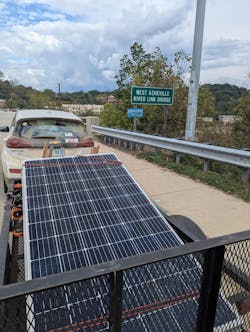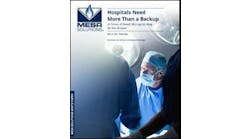After Hurricane Helene, Pop-Up Microgrids Powered Medical Clinics, Water Generators, Communications Equipment and Other Critical Resources
Since January 2020, Keith Thomson has met via Zoom from his home in Black Mountain, North Carolina, with a group of energy industry members aiming to promote the use of microgrids and distributed energy resources, especially to power critical services during emergencies.
On Sept. 27 Hurricane Helene struck close by and, for the first time, the Zoom meeting was canceled. In nearby Asheville, the storm knocked out power, killed cell service, flooded neighborhoods, downed trees, left residents without clean drinking water and killed 95 people in Western North Carolina.
Thomson’s neighbors along Flat Creek and the Swannanoa River took the brunt of the extreme flooding, said Thomson, co-founder and convenor of the Critical Services Microgrid Group.
Several main roads leading to Asheville were washed away or blocked by mudslides, and the city’s water system was damaged. Residents scooped creek water into buckets so they could flush toilets.
“The Critical Services Microgrid Group was built for this moment,” said Thomson.
Ensuring local organizations have access to clean energy
Thomson leapt into action, partnering with emergency response organizations, including Footprint Project – which provides clean energy during disasters – to power critical facilities, among them a senior living center’s medical clinic, a mental health center and churches attempting to meet the needs of local communities.
One of Thomson’s first priorities: connecting Footprint Project to local organizations to ensure mobile microgrids could be deployed where they were needed most. He also wanted to find lodging for the Footprint Project team.
On Sept. 30, Thomson met with Will Heegaard, operations director at Footprint Project, and Jamie Swezey, program director at the organization. He introduced the pair to local emergency service organizations and the Western North Carolina Conference of the United Methodist Church so they could begin deploying their systems.
“Footprint Project needed local people and connections to tell them where to go,” Thomson said. “Merging our deep local community networks with surging, incoming clean energy assets and technical resources in a typically chaotic moment has been a challenge.”
Thomson drove his Chevy Bolt tractor trailer – charged by a rooftop solar system – to redeploy a microgrid system initially installed at the CooperRiis Mental Health halfway house. That organization then housed Footprint Project staff for 16 days, he said.
Battery inverters for ventilators and a tornado victim
At the Givens Estates retirement community’s medical center, which had no power and whose backup generator was down, Thomson provided battery inverters to power ventilators.
He and his associates also helped provide battery inverters to Warren Wilson College’s president’s house and to the home of a tornado victim, among others, he said.
In addition, Thomson and his team delivered 1,250 gallons of bottled drinking water to two downtown churches with commercial kitchens so the non-profit organization Equal Plates could cook 1,800 hot meals a day, five days a week.
Requests for help poured in
Meanwhile, Footprint Project was inundated with calls for help.
“We’ve been overwhelmed with requests for power, water and communications, and have been intaking, triaging, deploying, demobilizing, redeploying, delivering and coordinating help as best and as fast as we can,” said Footprint Project in a Linkedin post.
To date, Footprint Project has raised more than $200,000 and allocated about $400,000 worth of sustainable response equipment to communities affected by the storm, said Heegaard in a summary of the organization’s work.
The nonprofit organization has provided portable solar generators, mobile solar microgrids, atmospheric water generators and satellite communication hubs to 40 sites.
A number of organizations provided funding ahead of hurricane season, allowing Footprint Project to respond more efficiently and effectively, said Swezey.
They include Schneider Electric, Direct Relief, Target, PosiGen, New Energy Equity and Arcadia.
Solar microgrids power well pump, fire stations, churches
Footprint Project’s work included:
- Running a well pump on a solar microgrid so that a community of mobile home parks in Asheville could source and share water.
- Facilitating the drops of portable batteries, flexible solar panels and Starlinks out of helicopters so families isolated on the tops of mountains could reach out for help.
- Setting up solar microgrids at rural fire stations, churches, health centers and makeshift community hubs to run refrigerators, freezers and communications, and displace/supplement their gas generators.
“We delivered a portable solar generator to a woman on an oxygen machine whose generator failed. We’ve set up multiple atmospheric water generators so people can flush their toilets and keep relief teams hydrated without using or tapping into single-use bottled water resources,” said Heegaard.
The team also created battery libraries so people could run medical devices without gas generators.
Part of the organization’s efforts included deploying a pop-up microgrid at Pensacola United Methodist Church in the hard-hit South Tow River valley. The power was used to run water pumps and lights at the command center located there, said Thomson.
100 portable solar generators from New Use Energy
Also on the ground in areas hard hit by Hurricane Helene is equipment from New Use Energy, which deploys portable solar generators. The company now has about 100 solar generators in the regions hit by the hurricane, said Paul Shmotolokha, CEO and director of New Use Energy.
They include 128-pound Suncase 3651 units, which have a 3.6-kW inverter, 5.1 kWh of battery and a 1,650-watt photovoltaic (PV) input in a portable case, he said. The company also has on the ground Sunkits with battery extensions that run atmospheric water generators, providing up to 12 gallons a day of water made from air. They include a 5-kW inverter, 10 kWh of battery and up to 5 kW of temporary PV input. The company also built a solar trailer for a relief organization with 60 kWh of battery, a gas generator and 12 kW of inverter power that includes a 100-gallon-a-day atmospheric water generator, he said.
The benefits of an electric car during emergencies
While the organizations deployed these systems, Thomson continued his efforts to provide relief, relying on his Chevy Bolt and its trailer to get around while others had trouble obtaining gasoline for their cars and trucks.
“The Chevy Bolt performance in transport for the Footprint Project staff and as a work vehicle never required getting in a line at gas stations that early on were struggling to have power for their pumps or internet for their point of sale systems,” Thomson said.
Thomson’s Chevy Bolt also took him to the mobile microgrids and solar microgrid he had helped install at Warren Wilson College’s Center for Working Lands, where he found that everything was operating as planned, in spite of being exposed to flood waters.
The project at Warren Wilson College includes golf carts, with 60 kWh of storage capacity and 15 kW of solar charging capacity, that not only transport the students, staff and faculty but also can be used to charge power tools, outdoor lighting and sound systems at the center. The college had also installed a solar microgrid to charge two electric tractors. The 15-kW microgrid-powered electric tractor charging shed includes a 61.4-kWh battery system and two inverters, and it powers two fast chargers. The microgrid’s batteries had gotten wet but were not damaged.
Disability center planned for emergencies with solar generators
In Florida, New Use Energy solar generators and trailers purchased earlier this year by the Disability Resource Center of the Panhandle were already deployed when Helene hit the state.
“They were all ready for it!” said Shmotolokha.
The solar generators were purchased to support disabled people with wheelchair recharging, device charging and battery operated medical devices, he added.
While the hurricane was devastating, it offered lessons about the importance of powering critical services with microgrids, Thomson said.
“The Critical Services Microgrid Group network was built over the past five years to be prepared for just this event. This is the teachable moment for building back better,” he said.
Donations to the hurricane response efforts can be made to:
Critical Services Microgrid Group: Clean Energy Disaster Relief for Western North Carolina (write CCSG in the comment section).
Footprint Project: Sustainable Energy Response for Hurricane Helene.









